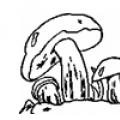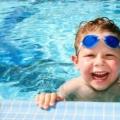“Gifts of Winter” by S.L. Prokofiev, lesson plan for reading (grade 4) on the topic. Gift for the Snow Maiden
Kolobushkina Anzhelika Vladimirovna MOU GOOSH department of correctional education VIII kind. Kalyazin, Tver region. Primary school teacher
Lesson on the development of oral speech based on the study of objects and phenomena of the surrounding reality. Subject: Seasonal changes in nature with the arrival of autumn. Goals: 1. Expanding students’ understanding of seasonal changes in nature with the arrival of autumn. 2. Development of students’ speech, expansion of vocabulary, development of cognitive interest. 3. Correction of logical thinking. 4. Cultivating a love of nature and observation.
During the classes.
1. Organizational moment.
Every day, always, everywhere. In class, at work. We speak boldly, clearly and sit quietly.
2. Studying new material.
Guys, we have guests today. Do you want to know who? Guess the riddle and find out.
Came without paints
And without a brush
And repainted it
All leaves.
But I don't touch the pine trees
And Christmas trees. I... (autumn).
Right. But Autumn did not come to us alone. She brought her younger brother with her. How many of you guessed who this brother was? Guess the riddle and find out.(Month – September.)
Mystery.
The collective farm garden is empty, cobwebs are flying into the distance,
And the cranes flocked to the southern edge of the earth.
School doors opened. What month has it come to us?(September.)
Well done. How did you guess? Autumn's younger brother loves to play. Let's play ball. I will ask a question and throw the ball, and you will answer and throw the ball back to me.
How many seasons do you know?
What seasons do you know?
What time of year is it now?
What month is it?
What month was before him?
What month is next?
What's peeking out from behind the clouds?
What color are the leaves in the autumn?
What wind blows in autumn?
What does rain do?
What are the birds doing?
Well done. We named the signs of autumn. Let's repeat them.
3.Working with demonstration material.
Images:
Sun. (The sun heats less).
Hat, jacket, boots. (It's getting colder outside.)
Symbols of day and night are long black and short yellow stripes. (The day gets shorter, the night gets longer.)
Umbrella. (It rains often).
Tree. (The leaves began to turn yellow and fall off.)
Bird. (Birds fly south).
Repetition of the signs of autumn using reference pictures in a chain, then by one student.
Conclusion: Autumn has just begun, there are still few yellow leaves in September, and it is not yet very cold. They say that September is the beginning of autumn, or, in other words, early autumn.
Students repeat the phrase “early autumn” several times in chorus and individually.
4.Work with proverbs.
The guys “pluck” leaves from an autumn tree. Proverbs written on pieces of paper:
September sees off the red summer and welcomes the golden autumn.
September hurries the birds on their way.
In September, even a leaf does not stick to the tree.
September smells like apples, and October smells like cabbage.
In September there is one berry, and that bitter rowan.
September is the evening of the year.
Physical education minute (reading text accompanied by movements).
The wind is blowing in our faces.
The tree swayed.
The tree is getting higher and higher.
The wind is quieter, quieter, quieter.
5. Consolidation.
Guys, autumn did not come to us empty-handed, but with gifts.
A student reads the poem “Gifts of Autumn” by S. Prokofiev
Questions and tasks
What fruits ripen in September?
What mushrooms grow in the September forest?
Guess the riddles:

Small, remote
Passed through the earth
I found Little Red Riding Hood.(Mushroom)
Little Ivan,
Bone caftan.(Nut)
One mother
A thousand sons.
She gave everyone a hat,
But I didn’t take it for myself.
(Oak, acorns)
Turned green in spring
Sunbathed in the summer
I put it on in the fall
Red corals.(Rowan)
4. Draw and color a bunch of rowan berries, acorns, nuts, mushrooms (a basket with mushrooms).
Game "Funny Poems" (Correctly - clap, incorrectly - stomp and explain).
Birch leaf in autumn
Absolutely pink. (Not pink, but yellow.)
The pine tree has needles,
Shorter than a Christmas tree. (Not shorter, but longer.)
It's cold in the fall
We walk through the puddles. (We don’t go for walks, we stay at home.)
So that it is warm in the fall,
Let's put on our coat. (This is right.)
6. Reflection. Summarizing.
Draw the sun a mouth that matches your mood right now.
Used Books:I.A. Morozova, M.A. Pushkareva Acquaintance with the surrounding world.M.: “Mosaic - Synthesis”, 2007
T.N. Ilyushina Development of mental activity of young children, V.:"Teacher Publishing House", 2011
L.G. Selikhova Familiarization with nature and speech development.M.: “Mosaic - Synthesis”, 2006
S.N. Sazonova Development of speech in preschool children with general speech underdevelopment.
Shorygina T.A. What months of the year?! Journey into the natural world. Speech development. A book for educators, tutors and parents,M.: Publishing House GNOM and D, 2000
Lesson topic: S.L Prokofiev “Gifts of Winter”
Target: get acquainted with winter phenomena, learn to distinguish the signs of winter, establish the relationship between cold weather and people’s lives. Development of reading and speech technique and expressiveness in children.
Tasks:
1. Educational: getting acquainted with a new work and improving reading technique; learn to find the main signs of winter;
2. Correctional and developmental: correct and develop coherent speech;
correct mental activity based on riddles;
3. Educational: cultivate observation of winter natural phenomena and develop a sense of beauty.
Download:
Preview:
Lesson topic : S.L Prokofiev “Gifts of Winter”
Target : get acquainted with winter phenomena, learn to distinguish the signs of winter, establish the relationship between cold weather and people’s lives. Development of reading and speech technique and expressiveness in children.
Tasks:
1. Educational:getting acquainted with a new work and improving reading technique; learn to find the main signs of winter;
2. Correctional and developmental:correct and develop coherent speech;
correct mental activity based on riddles;
3. Educational:cultivate observation of winter natural phenomena and develop a sense of beauty.
Equipment: interactive whiteboard, presentation, pictures about winter, cards with syllables, puzzles.
Textbook: textbook for grade 4 of special (correctional) educational institutions of type 8, author-compilers S.Yu. Ilyina, L.V. Matveeva
Lesson type: combined.
Lesson format: traditional.
Teaching methods : problematic presentation; explanatory and illustrative; reproductive; practical; partially search.
Forms of work : frontal; group; individual.
Use a variety of techniques when learning new material.: working with a textbook, asking problematic questions.
Differentiated approach: weak students, instead of reading the poem by heart, read it from the textbook.
During the classes
I. Organizational moment.
teacher
The bell has rung for us
Everyone stood up at their desks beautifully
Greeted politely
Students say hellousing your fingers.
“I wish you great success
in everything and everywhere - hello!
Warm up.
Target: Develop speech breathing.
Sit down correctly.
Before starting work, let's do a breathing warm-up.
inhale through the nose, exhale through the mouth
inhale, hold your breath. exhalation
inhale, exhale in portions
Warm up for the tongue
Who wants to talk
He must reprimand
Everything is correct and clear
To make everything clear
Slide 1 Practical warm-up
Patter
Radish rarely grew in the garden,
The bed was rarely in order
Checking homework
I have a ball of snow in my hands. (a ball of cotton wool) I throw a snowball at you and ask questions, and you answer them.
Tell me, what work did we meet in the last lesson?
What was your homework?(Find funny lines in the poem and read them with expression.)
Guys, now we need to find out what poem we are going to read in today's lesson?
Exercise to develop reaction speed: Slide 2
– Read the words
snow, blizzard, gifts, snowy, frost, winter, snowdrifts.
Work for Interact. blackboard
and underline the words: gifts, winter
To find out the title of the next work you need to make a sentence from the words.
Who will read the proposal?
Communicating the topic and objectives of the lesson
Today we will get acquainted with another work about winter, it is called....
(For the gift of winter) we opened our textbooks
Autobiography of S. Prokofieva.
–Sofya Leonidovna Prokofieva is a Russian writer, author of wonderful children's fairy tales. Born in Moscow on May 14, 1928 in the family of an artist... Slide
As you read the poem, you will come across words that are unfamiliar to you.
Working with the textbook.
a) Vocabulary work.
Target: give students a concrete idea of the words being studied.
pulled it on - dressed casually
early in the morning - very early
curls- these are patterns with wavy curved lines
Physical exercise. (to music)
How are you? - Like this! (Show thumb.)
How are you going? - Like this! (“Walk” with two fingers on the palm.)
Are you running? - Like this! (Bend their arms at the elbows and show how they work with them when running.)
Do you sleep at night? - Like this! (Put their hands under their cheeks and place their head on them.)
How do you take it? Like this! (Make grasping movements with their hands.)
Will you give it? - Like this! (They make movements with their hands. As if they are giving something.)
How are you being naughty? - Like this! (They puff out their cheeks and lightly slap them with their palms.)
Are you threatening? - Like this! (They shake their finger at their neighbor.)
Learning new material
1) Primary reading of the poem by the teacher.
Exercise for the eyes
2) Read the poem expressively, conveying the mood in your voice.
- Working with 1 column.
What did Winter bring to the yard?
Working with 2 columns.
Read it yourself and find it in the text. Why did stars, leaves, and curls appear on the windows? (Children's answers)
Work in pairs.
Read column 3 to each other and answer the question.
Why did the guys feel hot in December?
What lines of the poem can these pictures be attributed to? Find in the text and read.
Exercise: making sentences with prepositions. Annex 1
Lesson summary.
-What did you read? What and who did you read about?
– What new did you learn?
What did they make up?
Assessment
Homework
Sasha, Nikita, Yura - by heart
Mindset for a change
That's the end of the lesson,
He went, I hope, for future use.
There is absolutely nothing special in this fairy tale. Honestly.
And why did she captivate me so much? Maybe just because of its simplicity. To write a fairy tale with talent and simplicity and at the same time not go into either primitiveness or complexity - this is still a talent, I tell you. And Sofia Prokofieva clearly has it.
The tale is really quite simple. In a nutshell - about how animals and toys saved Snegurochka from the wolf and fox who kidnapped her. About how friendship, care, self-confidence defeats cunning and lies :)
A little fairytale magic, good humor, catchy songs - a wonderful story is ready! What a funny little cone with his pockets from which nuts were constantly falling out, and the brave Bell, and the hare Mitroshka, who, although he was afraid, walked into danger for the sake of his friend.
You can role-play with your children, you can read before bedtime, singing songs together, of which there are many in the book and they are very cute and simple, you can look at the wonderful illustrations.
I won’t say that this book is a must-have, but how difficult it is nowadays to find a good New Year’s fairy tale book for readers aged 2-3-4 years (I’m giving approximate ages, since everything is very individual after all), when “Rozhdestvensky’s Letters” It may still be early for grandfather and The Nutcracker, but you already want a fairy tale about a New Year's miracle.
Therefore, I will undoubtedly keep this book with me, and under the cut I give you the first chapters and illustrations to read.













Lesson topic: S.L Prokofiev “Gifts of Winter”
Goal: get acquainted with winter phenomena, learn to distinguish the signs of winter, establish the relationship between cold weather and people’s lives. Development of reading and speech technique and expressiveness in children.
Tasks:
1. Educational: acquaintance with a new work to improve reading technique; learn to find the main signs of winter;
2. Corrective and developmental: correct and develop coherent speech;
correct mental activity based on riddles;
3. Educational: to cultivate observation of the phenomena of winter nature and develop a sense of beauty.
Equipment: interactive whiteboard, presentation, pictures about winter, cards with syllables, puzzles.
Textbook: textbook for grade 4 of special (correctional) educational institutions of type 8, author-compilers S.Yu. Ilyina, L.V. Matveeva
Lesson type: combined.
Lesson format: traditional.
Teaching methods: problem presentation; explanatory and illustrative; reproductive; practical; partially search.
Forms of work: frontal; group; individual.
When studying new material, use a variety of techniques: working with a textbook, asking problematic questions.
Differentiated approach: weak students, instead of reading a poem by heart, read it from a textbook.
During the classes
I. Organizational moment.
teacher
The bell has rung for us
Everyone stood up at their desks beautifully
Greeted politely
Students say hello using their fingers.
“I wish you great success
in everything and everywhere - hello!
Warm up.
Goal: To develop speech breathing.
-Sit down correctly.
Before starting work, let's do a breathing warm-up.
inhale through the nose, exhale through the mouth
inhale, hold your breath. exhalation
inhale, exhale in portions
Warm up for the tongue
-To read better, we need to stretch our tongues
Who wants to talk
He must reprimand
Everything is correct and clear
To make everything clear
Slide 1 Practical warm-up
Patter
-Radish rarely grew in the garden,
The bed was rarely in order
Checking homework
-I have a lump of snow in my hands. (a lump of cotton wool) I throw a snowball at you and ask questions, and you answer them.
- Tell me, what work did we meet in the last lesson?
-Who is the author of the poem? (With Sasha Cherny’s poem “The Snow Woman.”)
-What was your homework? (Find funny lines in the poem and read them with expression.)
Guys, now we need to find out what poem we are going to read in today's lesson?
Exercise to develop reaction speed: Slide 2
– Read the words
snow, blizzard, gifts, snowy, frost, winter, snowdrifts.
Work for Interact. blackboard
and underline the words: gifts, winters
To find out the title of the next work you need to make a sentence from the words.
- Who will read the proposal?
Communicating the topic and objectives of the lesson
-Today we will get acquainted with another work about winter, it’s called....
(For the gift of winter) we opened our textbooks
-Who is author? (Sofya Leonidovna Prokofieva)
Autobiography of S. Prokofieva.
–Sofya Leonidovna Prokofieva is a Russian writer, author of wonderful children's fairy tales. Born in Moscow on May 14, 1928 in the family of an artist...Slide
-When reading the poem, you will come across words unfamiliar to you.
Working with the textbook.
a) Vocabulary work.
Purpose: to give students a specific idea of the words being studied.
pulled it on - dressed casually
early in the morning - very early
curlicues are patterns with wavy, curved lines
Physical exercise. (to music)
How are you? - Like this! (Show thumb.)
How are you going? - Like this! (“Walk” with two fingers on the palm.)
Are you running? - Like this! (Bend their arms at the elbows and show how they work with them when running.)
Do you sleep at night? - Like this! (Put their hands under their cheeks and place their head on them.)
How do you take it? Like this! (Make grasping movements with their hands.)
Will you give it? - Like this! (They make movements with their hands. As if they are giving something.)
How are you being naughty? - Like this! (They puff out their cheeks and lightly slap them with their palms.)
Are you threatening? - Like this! (They shake their finger at their neighbor.)
Learning new material
1) Primary reading of the poem by the teacher.
-I will read, and you listen carefully.
Exercise for the eyes
2) Read the poem expressively, conveying the mood in your voice.
-Work with 1 column.
-You must find it in the text and read it.
-What did Winter bring to the yard?
Working with 2 columns.
-Read it yourself and find it in the text. Why did stars, leaves, and curls appear on the windows? (Children's answers)
Work in pairs.
-Read the 3rd column to each other and answer the question.
-Why did the guys feel hot in December?
-What lines of the poem can these pictures be attributed to? Find in the text and read.
Assignment: writing sentences with prepositions. Annex 1
Lesson summary.
-What did you read? What and who did you read about?
– What new did you learn?
- What did you make up?
Assessment
Homework
Sasha, Nikita, Yura - by heart
Vova – Read. Draw a picture for the poem.
Mindset for a change
So the lesson ended, He went, I hope, for future use.
 L Prokofiev lesson plan on reading (4th grade) on the topic
L Prokofiev lesson plan on reading (4th grade) on the topic Lesson summary "Rules and safety measures on reservoirs in the summer" outline plan for healthy lifestyle on the topic
Lesson summary "Rules and safety measures on reservoirs in the summer" outline plan for healthy lifestyle on the topic Eva Polna - silence lyrics
Eva Polna - silence lyrics